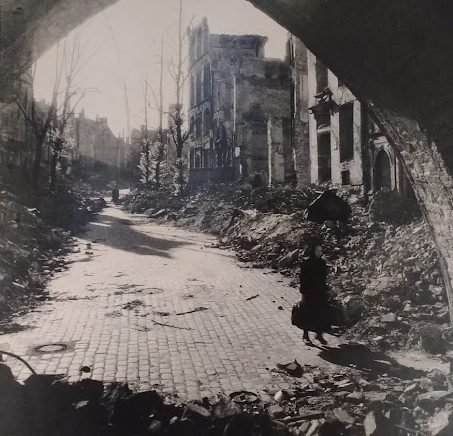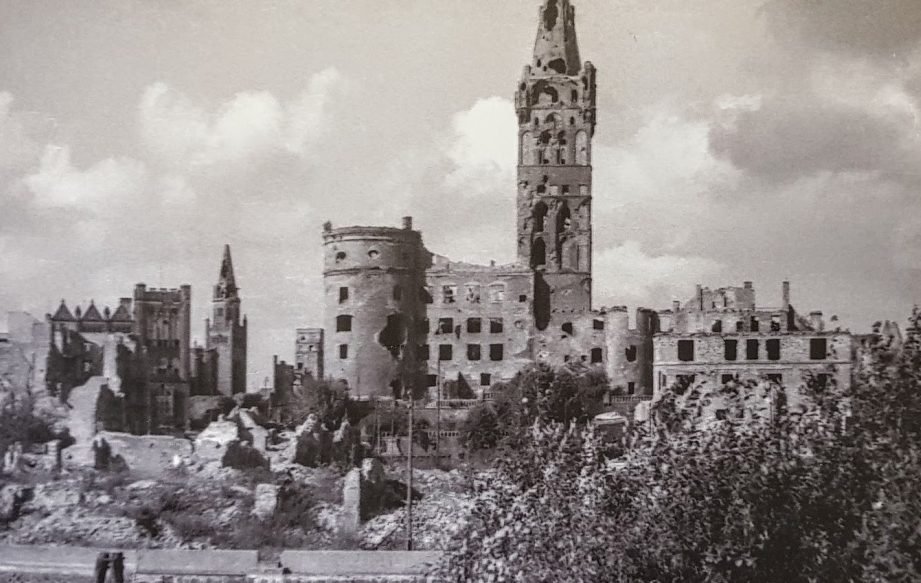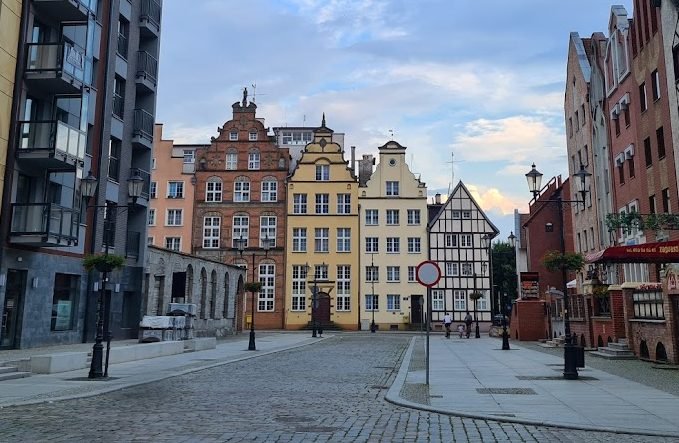Imagine this: it’s the summer of 1945, and your country has suddenly inherited large swaths of formerly-German territory. Many of the smaller towns and villages are move-in ready – as soon as you kick out any Germans still left. Your new territory also includes several historically- and economically-significant cities with a rich cultural heritage, sometimes intertwined with yours, but sometimes not. And another thing: a combination of extensive Allied bombing raids and destruction wraught by the Red Army’s advance has reduced most of these cities to heaps of rubble. The vast majority (70-80%+) of buildings in these city centres are damaged beyond repair – at best, a smoking husk; at worst, a shapeless pile of debris.



At the same time, millions of people in your own homeland, also ravaged by war, are homeless and starving. Your own cities – the ones belonging to your country prior to the war, in which your people have lived for centuries – have also suffered immense destruction through the German war of aggression, and are in dire need of their own reconstruction plans.
So what do you do with these destroyed German cities?
What do you do with the crumbled remains of Stettin, Danzig, Elbing, Königsberg?

These were very real questions in 1945, when Poland (and to a lesser extent, Russia and Lithuania) took possession of formerly German territories that had been severely damaged in the war. The cities they received in compensation were in theory economically valuable, but currently lay in ruins.
Some cities didn’t have a choice. Under the ‘Bricks for Warsaw’ plan, for example, many newly-Polish cities (such as Wrocław, formerly Breslau) were required to tear down war-damaged buildings and ship the recovered materials to Warsaw in order to help rebuild its own devastated city centre, which had been burned to the ground by the Nazis in retribution for the 1944 Warsaw Uprising. Despite the arguably noble intention, this campaign is behind many of the less-than-inspiring post-war ‘rebuilds’ in the cities of western and northern Poland.


But, back to the question: what do you do with a destroyed city?
You could do what Szczecin (formerly Stettin) did: rebuild some of the most important sites, like the Maritime Academy and Castle of the Pomeranian Dukes, but otherwise demolish the remains of the former city centre and build a completely new one on top, with new boulevards, new mass apartment blocks, and new shopping centres.

You could do what Kaliningrad (formerly Königsberg) did: clear the rubble, leave the former city centre as an empty series of parks and lots, and build a new, unrecognisably different city next to where the old one used to be.


You could do what Gdańsk (formerly Danzig) did: recreate the historic city centre in such a way that it really looks authentic, such that the average visitor can’t even tell that the buildings are only decades old, and not centuries. Except for the politically-unacceptable German influence over the last couple of centuries, which is consciously ignored in the reconstruction. The city centre is rebuilt to emphasise architectural influences from the other Baltic nations and from western Europe, and to erase anything too identifiably ‘German’.

Alternatively: you could do what Elbląg (formerly Elbing) has done, or rather, is in the process of doing… a sort of middle way, rebuilding its historic city centre under the guiding philosophy of retroversion.

Elbląg/Elbing is a city near the Baltic coast in the historical region of Masuria, once part of East Prussia and now in northern Poland. It is one of the oldest surviving cities in the region, and – like many central/eastern European cities – has changed hands several times over the centuries. Founded in the 1200s, it was part of the Hanseatic League before it came under Polish(-Lithuanian) influence in the mid-15th century. The city was then annexed by Prussia towards the end of the 1700s, and remained in Prussian/German hands until World War II, when it became part of Poland.

Elbląg’s main claim to fame is the eponymous Elbląg canal, a 19th century waterway that uses rail cars and pulley systems to transport boats over hilly sections of the route – an impressive feat of modern engineering at the time and now one of the ‘Seven Wonders of Poland’.

As with most East Prussian cities, Elbląg/Elbing’s Old Town was left devastated at the end of World War II. Unlike its larger neighbour, Gdańsk, the Old Town of Elbląg was not rebuilt directly after the war, but was torn down and left as empty space while the authorities debated what was to be done.
Elbląg did have some historical connection to Poland – in fact, it was under the Polish-Lithuanian Commonwealth that the city first flourished – but it was not as economically or culturally significant to the Poles as larger cities like Gdańsk, Warsaw or Wrocław. It lacked what one advocate would later call the ’emotional incentive’ for reconstruction. By the time it passed into Polish hands in 1945, it had been German for nearly two centuries; its new inhabitants felt no particular connection to the historic centre, and no desire to expend the money and effort it would take to reconstruct it.
In the 1960s, Elbląg came close to following in the steps of Szczecin, with plans for a completely re-organised, newly-constructed, Communist-style city centre. However, these plans were ultimately scrapped due to opposition from local and architectural organisations, leaving the city’s Old Town in a Kaliningrad-like limbo of empty lots while the debate about its future carried on.


According to local lore, it was an April Fool’s Day prank in 1983 that finally resurrected the plans to redevelop the city centre. As a joke, the local newspaper, Wiadomości Elbląskie, published a call for residents interested in receiving an apartment in the Old Town – which was at the time little more than a parking lot – to contact city authorities for an appointment. The response was reportedly so overwhelming that the city was compelled to hold a public meeting on the issue. Serious planning for the reconstruction of the city centre was revived later the same year.
Rather than attempt a neo-historical reconstruction like Gdańsk or an entirely new construction like Szczecin or Kaliningrad, city authorities decided early on to pursue an approach that they called retroversion.

The retroversion concept was developed specifically for Elbląg in the 1980s by the voivodeship’s head conservationist, Prof. Maria Lubocka-Hoffmann, who would become instrumental in advocating for this brand-new approach to post-war reconstruction. The central idea of retroversion was to preserve the historical framework of the city – the layout of the city centre, the locations of key buildings, the width and lot size of the residential blocks – while making the architectural characteristics of the new buildings explicitly modern. In fact, the official retroversion guidelines developed for Elbląg advised against attempts to imitate a ‘historical’ aesthetic.
According to Elbląg’s 1997 redevelopment plan:
Tenement houses should be designed in individual contemporary architectural forms, eliminating the historicising style. Historical details may be used in a way that does not suggest that a tenement house is a reconstructed building or an original from a specific era. The architecture being designed must bear the mark of the time and place in which it was created, and at the same time demonstrate universal aesthetic values.
In other words, new buildings can make use of historical elements – like the red brick of the Hanseatic style, the half-timbered medieval style, patterns and designs common to traditional Prussian buildings – as long as the building is still recognisably ‘modern’, and cannot be confused with a historical reproduction. Indeed, many retroverted buildings in the city centre do make liberal use of historical influences from the city’s past. Consider, for example, Elbląg’s reconstructed city hall (below left), which takes visual inspiration from its historically-preserved cousins in nearby cities (centre and right), but is still clearly a modern building.



In this respect, Elbląg’s late start in the reconstruction of its Old Town worked in its favour. By the time that serious planning for the retroversion of Elbląg’s city centre took off in the 1980s, the initial ‘patriotic’ fervour that shaped neo-historical reconstruction in other Polish cities like Gdańsk – where the Old Town was rebuilt to look authentic, while in reality erasing many of its German influences – had faded. Younger architects and planners like Lubocka-Hoffmann, who was then in her 30s, felt more free to draw on ‘Germanic’ elements from the city’s past in order to create an entirely new style – one that pays homage to its recent history while still looking explicitly towards the future.




The retroversion style itself has also visibly improved over time, especially with the inflow of new money after the collapse of the Communist regime in 1989 and Poland’s accession to the EU in 2004. Compared to the newer buildings of the 2000s and 2010s (below right), the earliest retroversions from the late 1980s (below left) stand out as particularly bland. As a result, it’s possible to walk through the city centre and clearly identify which parts were reconstructed at which time. The reconstruction is highly transparent, and honest – unlike the Old Towns of Warsaw or Gdańsk, it isn’t trying to trick you into believing that the buildings are any older than they really are.


The local authorities call Elbląg’s rebuilt city centre the Nówka Starówka – the ‘Brand New Old Town’. It’s a remarkably accurate description. The atmosphere feels similar to any other European ‘Old Town’, with its narrow, mixed-use tenement buildings, emphasis of pedestrian traffic, and orientation around city gates and a central square. But no one walking through its streets would get the impression that it is genuinely old, and that is precisely the point.

The retroversion approach was a bold one that went against the more conventional path of neo-historical reconstruction, and Elbląg has been – in my opinion, unfairly – penalised by travel guides as a result. My English-language guidebook described Elbląg’s rebuilt Old Town as ‘sterile’ und ‘lifeless’. I almost avoided it as a result, but felt compelled to visit out of respect for its historical significance. I’m so glad that I did. What I found in Elbląg was much more interesting than another faux-historical reproduction: I found a city not trying to recreate its past, but to respect it – a city pioneering a novel approach of moving forward while acknowledging its complicated roots.
It’s a shame that conventional travel rewards a convincing lie – like the Old Towns of Gdańsk or Warsaw – over a messier truth. And yet I fully buy into it myself; I love the reconstructed Gdańsk. Still: I think there ought to be more room in Europe – and in the hearts of European travellers – for places like Elbląg. Gdańsk may be more beautiful, but Elbląg is more honest.



It reminds me a bit of the transition to modern art. Renaissance, Baroque, and Romantic art always strove to imitate life as closely as possible, to make you believe that what you’re looking at could be real. Modern art recognised that whatever it depicted would never be real – that even the most realistic paintings in the world are still just strokes of paint on a canvas. Artists were freed from having to depict the world as it was, and were able to explore entirely new forms of expression. The result was an explosion in new and creative ways of perceiving, processing, and portraying the world around us.
Likewise, Elbląg is aware that it will never be Elbing – and rather than try to imitate it, Elbląg has decided to pay tribute to its predecessor without allowing it to determine its future course. It has chosen something bold and new instead of tried and true. I respect that.

Schreibe einen Kommentar